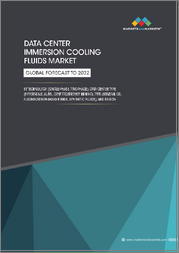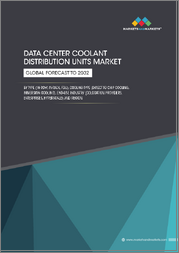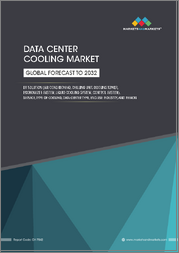
|
시장보고서
상품코드
1776231
아시아태평양의 데이터센터 냉각 시장 : 제품별, 용도별, 국가별 - 분석과 예측(2025-2035년)Asia-Pacific Data Center Cooling Market: Focus on Product, Application, and Country-Level Analysis - Analysis and Forecast, 2025-2035 |
||||||
아시아태평양의 데이터센터 냉각 시장 규모는 2024년 94억 6,000만 달러에서 2035년에는 411억 달러에 달하며, 예측 기간인 2025-2035년의 CAGR은 13.61%에 달할 것으로 예측됩니다.
아시아태평양의 디지털 인프라, 클라우드 사용 및 데이터 생성 증가에 따라 고급 데이터센터 냉각 솔루션의 필요성이 증가하고 있습니다. AI 및 고성능 컴퓨팅과 관련된 작업 부하가 증가함에 따라 장비의 수명과 가동 시간을 유지하기 위해서는 효과적인 냉각 솔루션이 필수적입니다. 각국 정부의 에너지 효율 요건, 물 사용량 제한, 냉매 규제 강화로 인해 지속가능한 저부하 냉각기술이 확산되고 있습니다. 국가 지속가능성 목표를 달성하기 위해 싱가포르, 호주, 인도 등의 국가들은 크로스 드랍 시스템, 프릭킹, 저 GWP 냉매를 추진하고 있습니다. 기술 혁신으로 AI를 활용한 기류 제어, 액체 냉각, 침지 시스템의 채택이 가속화되고 있지만, 높은 초기 비용과 통합의 어려움 등의 장애물이 여전히 큰 걸림돌로 작용하고 있습니다. 그러나 보다 친환경적이고 효과적인 디지털 인프라를 추구하는 움직임은 아시아 각국의 데이터센터의 냉각 전술을 바꾸고 있습니다.
| 주요 시장 통계 | |
|---|---|
| 예측 기간 | 2025-2035년 |
| 2025년의 평가 | 114억 7,000만 달러 |
| 2035년 예측 | 411억 달러 |
| CAGR | 13.61% |
시장 소개
아시아태평양의 데이터센터 냉각 시장은 클라우드 컴퓨팅, AI, 디지털 전환의 사용 확대로 인해 빠르게 성장하고 있습니다. 데이터센터의 밀도가 높아지고 랙의 전력 수준이 10kW에서 30kW 이상으로 증가함에 따라 가동 시간, 성능 및 규정 준수를 유지하기 위해서는 효과적이고 지속가능한 냉각 솔루션이 필수적입니다. 증가하는 열부하에 대한 대응을 강화하기 위해 사업자들은 기존 CRAC/CRAH 유닛에서 액침냉각, 리어 도어 열교환기, 칩 직하 수랭식 등 최첨단 기술로 적극적으로 전환하고 있습니다.
싱가포르, 호주, 인도, 일본 등 에너지 효율 기준, 물 사용량, 저GWP 냉매 의무화를 시행하고 있는 국가들은 저부하, 교차도입, 하이브리드 냉각 시스템 도입에 대한 압박을 가하고 있습니다. 에너지 효율을 높이고 PUE(전력 사용 효율)를 낮추기 위해 AI를 활용한 열 관리, 모듈식 냉각 설계, 적절한 지역에서 플리킹을 사용하는 것이 점점 더 널리 보급되고 있습니다.
높은 초기 투자비용, 복잡한 개보수, 일부 지역에서는 물 부족 등의 장애물에도 불구하고 정부의 인센티브와 지속가능성 기준의 강화로 시장은 계속 성장하고 있습니다. 아시아태평양의 데이터센터 냉각 시장은 환경 규제가 강화되고 고성능 컴퓨팅에 대한 수요가 증가함에 따라 급성장할 것으로 예상되며, 궁극적으로 친환경적이고 미래지향적인 디지털 인프라의 중요한 컴포넌트가 될 것입니다.
시장 세분화
부문 1: 산업별 최종사용자별
- IT 및 통신
- 헬스케어
- 소매업
- 은행/금융서비스/보험, 금융 서비스, 보험
- 정부-공공기관
- 제조업
- 기타
부문 2: 데이터센터 유형별
- 집중형 데이터센터
- 하이퍼스케일
- 코로케이션
- 엔터테인먼트 상품
- 엣지 데이터센터
부문 3: 용도별
- 인공지능(AI)
- 고성능 컴퓨팅(HPC)
- 클라우드 컴퓨팅
- 엣지 컴퓨팅
- 기타
부문 4: 솔루션별
- 공랭식
- 에어컨
- 에어 핸들링 유닛
- 칠러
- 냉각탑
- 이코노마이저 시스템
- 기타
- 액체 냉각
- 직접 냉각
- 리어 도어형 열교환기(RDHX)
- 플리커링
부문 5: 랙 밀도별
- 낮은 랙 밀도(1-4kW)
- 중형 랙 밀도(5-9kW)
- 높은 랙 밀도(9kW 이상)
부문 6: 지역별
- 아시아태평양
아시아태평양의 데이터센터-냉각 시장 시장 동향 및 추진 요인-과제
시장 동향
- 랙 전력 밀도 상승을 관리하기 위한 수랭식 솔루션(직접-투-칩, 리어 도어 열교환기)의 신속한 채택
- 특히 고성능 컴퓨팅 및 AI 워크로드를 위한 액침냉각 파일럿의 성장세
- 모듈식 조립식 냉각장치의 확장으로 엣지 사이트 구축 및 확장성을 가속화하기 위한 모듈식 조립식 냉각장치 확대
- AI/ML 기반 모니터링 및 동적 기류 관리 통합으로 예지보전 및 효율성 향상
- 온화한 아시아태평양 기후에서 플리커링(에어사이드 및 워터사이드 이코노마이저) 사용 확대에 따른 냉각기 가동 시간 단축
- 경제 성장을 위한 서큘러스의 노력: 성숙한 시장에서의 지역난방 및 시설 재사용을 위한 폐열 회수
시장 성장 촉진요인
- 랙당 IT 부하 증가(10kW에서 30kW 이상)
- 기업의 순 제로 목표와 ESG 목표에 따라 시설 소유자는 PUE와 탄소발자국을 최소화해야 합니다.
- 물 사용 및 냉매 배출에 대한 엄격한 지역 규제로 인해 저GWP 냉매와 크로스 드루프 시스템 채택이 촉진되고 있습니다.
- 동남아시아, 인도, 호주에서 하이퍼스케일 데이터센터 및 엣지 데이터센터의 급속한 확산에 대한 수요
- 전기요금 상승으로 에너지 효율이 높은 냉동기와 공기 흐름 최적화에 투자하는 사업자가 늘고 있습니다.
시장이 해결해야 할 과제
- 첨단 냉각기술(수냉, 침지 시스템)의 초기 투자금액이 기존 CRAC 유닛에 비해 높습니다.
- 일부 아시아태평양의 물 부족은 수랭식 냉각기와 이코노마이저의 채택을 복잡하게 만들고 있습니다.
- 레거시 시설을 새로운 냉각 기술로 개조할 때 필요한 복잡한 통합 요건들
- 특수 냉각 시스템 설계, 설치, 유지보수에 대한 기술 및 인력 부족
- 냉매 취급, 방류, 에너지 효율에 대한 기준이 다양하고, 아시아태평양 전역에 걸쳐 규제 상황이 분절되어 있습니다.
- 세계 조달 압박 속에서 핵심부품(열교환기, 펌프, 특수냉매) 공급망에 대한 제약
제품/혁신 전략: 이 보고서는 아시아태평양 데이터센터 냉각 시장의 종합적인 제품/혁신 전략을 제공하고 시장 진입, 기술 채택, 지속가능한 성장 기회를 식별합니다. 이 보고서는 기업이 환경 기준을 충족하고, 경쟁 우위를 확보하며, 다양한 산업 분야에서 증가하는 친환경 솔루션에 대한 수요를 활용할 수 있는 실용적인 인사이트을 제공합니다.
성장/마케팅 전략: 이 보고서는 아시아태평양의 데이터센터 냉각 시장에 특화된 종합적인 성장 및 마케팅 전략을 제공합니다. 특화된 시장 부문 식별, 경쟁 우위 확보, 시장 점유율 및 재무 성과 최적화를 위한 창의적인 마케팅 전략 수립 등 타겟팅된 접근 방식을 제시합니다. 이러한 전략적 제안을 통해 기업은 시장에서의 존재감을 높이고, 새로운 전망을 포착하고, 효율적으로 매출 확대를 도모할 수 있습니다.
경쟁 전략: 이 보고서는 아시아태평양 데이터센터 냉각 시장에 맞는 강력한 경쟁 전략을 수립합니다. 시장의 경쟁자를 평가하고, 차별화할 수 있는 방법을 제안하며, 경쟁력을 유지할 수 있는 가이드라인을 제공합니다. 이러한 전략적 지침을 준수함으로써 기업은 시장 경쟁에서 효과적인 입지를 구축하고 지속적인 번영과 수익성을 확보할 수 있습니다.
주요 시장 진출기업 및 경쟁사 요약
아시아태평양의 데이터센터 냉각 시장에서 개요를 작성한 기업은 주요 전문가로부터 수집한 정보에 기반하여 선정되고 있으며, 기업의 커버리지, 제품 포트폴리오, 시장 침투도를 분석하고 있습니다.
이 시장에서 유명한 기업은 다음과 같습니다.
- PEZY Computing K.K.
- Fujitsu
목차
개요
제1장 시장
- 동향 : 현황과 향후에 대한 영향 평가
- 데이터센터 냉각 시장을 형성하는 동향
- 데이터 요건의 증가
- 친환경 냉각 시스템의 수요 증가
- 2024-2034년 액랭 도입을 향한 데이터센터의 동향
- 데이터센터용 증발 냉각 시장의 지역별 개요
- 공급망 개요
- 밸류체인 분석
- 시장 맵
- 연구개발 리뷰
- 특허 출원 동향(국가별·기업별)
- 에코시스템과 진행중인 프로그램
- 정부의 프로그램과 구상 상황
- 시장 역학 개요
- 시장 성장 촉진요인
- 시장 성장 억제요인
- 비즈니스 기회
- 데이터센터 냉각 시장에서의 주요 스타트업 기업
제2장 지역
- 지역의 요약
- 아시아태평양
- 아시아태평양의 주요 시장 참여 기업
- 비즈니스 촉진요인
- 비즈니스 과제
- 용도
- 제품
- 아시아태평양(국가별)
제3장 경쟁 벤치마킹과 기업 개요
- 향후 전망
- 지역적 평가
- 경쟁 구도
- 기업 개요
- PEZY Computing K.K.
- Fujitsu
제4장 조사 방법
KSA 25.08.01This report can be delivered in 2 working days.
Introduction to Asia-Pacific Data Center Cooling Market
The Asia-Pacific data center cooling market is projected to reach $41.10 billion by 2035 from $9.46 billion in 2024, growing at a CAGR of 13.61% during the forecast period 2025-2035. Advanced data centre cooling solutions are becoming more and more necessary as APAC's digital infrastructure, cloud use, and data generation all rise. Effective cooling solutions are essential to maintaining equipment longevity and uptime as workloads related to AI and high-performance computing increase. Sustainable, low-impact cooling technologies are becoming more popular as a result of regional governments enforcing stronger energy efficiency requirements, water usage caps, and refrigerant regulations. To meet national sustainability goals, nations like Singapore, Australia, and India are pushing for closed-loop systems, free cooling, and low-GWP refrigerants. Although innovation is speeding up the adoption of AI-driven airflow control, liquid cooling, and immersion systems, obstacles including high upfront costs and integration difficulties continue to be major obstacles. However, the drive for more eco-friendly and effective digital infrastructure is changing cooling tactics in data centres around Asia.
| KEY MARKET STATISTICS | |
|---|---|
| Forecast Period | 2025 - 2035 |
| 2025 Evaluation | $11.47 Billion |
| 2035 Forecast | $41.10 Billion |
| CAGR | 13.61% |
Market Introduction
The market for data centre cooling in Asia Pacific is expanding quickly due to the region's increased use of cloud computing, AI, and digital transformation. Effective and sustainable cooling solutions are now essential to maintaining uptime, performance, and regulatory compliance as data centre density rises and rack power levels climb from 10 kW to over 30 kW. In order to better handle increasing heat loads, operators are aggressively moving away from conventional CRAC/CRAH units and towards cutting-edge technologies like immersion cooling, rear-door heat exchangers, and direct-to-chip liquid cooling.
Data centre operators are being pushed to implement low-impact, closed-loop, and hybrid cooling systems by nations like Singapore, Australia, India, and Japan that are imposing tougher energy efficiency standards, water usage laws, and low-GWP refrigerant mandates. In order to increase energy efficiency and reduce PUE (Power Usage Effectiveness), AI-powered thermal management, modular cooling designs, and the usage of free cooling in appropriate regions are increasingly becoming more popular.
With the help of government incentives and sustainability standards, the market is still growing despite obstacles including high initial investment, complicated retrofits, and water scarcity in some areas. The APAC data centre cooling market is expected to grow quickly as environmental restrictions tighten and demand for high-performance computing increases, eventually becoming a vital component of green, future-ready digital infrastructure.
Market Segmentation
Segmentation 1: by End-Use Industry
- IT and Telecom
- Healthcare
- Retail
- Banking, Financial Services, and Insurance
- Government and Public Sector
- Manufacturing
- Others
Segmentation 2: by Data Center Type
- Centralized Data Center
- Hyperscale
- Colocation
- Enterprise
- Edge Data Center
Segmentation 3: by Application Area
- Artificial Intelligence (AI)
- High-Performance Computing (HPC)
- Cloud Computing
- Edge Computing
- Others
Segmentation 4: by Solution
- Air Cooling
- Air Conditioner
- Air Handling Unit
- Chiller
- Cooling Tower
- Economizer System
- Others
- Liquid Cooling
- Direct
- Rear Door Heat Exchangers (RDHX)
- Free Cooling
Segmentation 5: by Rack Density
- Low Rack Density (1-4 kW)
- Medium Rack Density (5-9 kW)
- High Rack Density (Above 9 kW)
Segmentation 6: by Region
- Asia-Pacific
Market trends, Drivers and Challenges of APAC Data Center Cooling Market
Market Trends
- Rapid adoption of liquid-cooling solutions (direct-to-chip, rear-door heat exchangers) to manage rising rack power densities.
- Growth in immersion-cooling pilots, especially for high-performance computing and AI workloads.
- Expansion of modular, prefabricated cooling units to accelerate deployment and scalability at edge sites.
- Integration of AI/ML-driven monitoring and dynamic airflow management for predictive maintenance and efficiency gains.
- Increasing use of free-cooling (air-side and water-side economizers) in temperate APAC climates to reduce chiller runtime.
- Circular-economy initiatives: waste-heat recovery for district heating or facility reuse in mature markets.
Market Drivers
- Escalating IT load per rack (from 10 kW to 30 kW+), necessitating more efficient thermal solutions.
- Corporate net-zero and ESG targets prompting facility owners to minimize PUE and carbon footprints.
- Stringent regional regulations on water use and refrigerant emissions, driving adoption of low-GWP coolants and closed-loop systems.
- Demand for rapid deployment of hyperscale and edge data centers across Southeast Asia, India and Australia.
- Rising electricity costs incentivizing operators to invest in energy-efficient chillers and airflow optimization.
Market Challenges
- High initial CAPEX for advanced cooling technologies (liquid cooling, immersion systems) versus traditional CRAC units.
- Water scarcity in certain APAC regions complicates adoption of water-cooled chillers and economizers.
- Complex integration requirements when retrofitting legacy facilities with new cooling architectures.
- Skills and talent shortages for design, installation and maintenance of specialized cooling systems.
- Fragmented regulatory landscape across APAC, with varying standards for refrigerant handling, water discharge and energy efficiency.
- Supply-chain constraints for critical components (heat exchangers, pumps, specialty coolants) amid global procurement pressures.
How can this report add value to an organization?
Product/Innovation Strategy: This report provides a comprehensive product/innovation strategy for the APAC data center cooling market, identifying opportunities for market entry, technology adoption, and sustainable growth. It offers actionable insights, helping organizations to meet environmental standards, gain a competitive edge, and capitalize on the increasing demand for eco-friendly solutions in various industries.
Growth/Marketing Strategy: This report offers a comprehensive growth and marketing strategy designed specifically for the APAC data center cooling market. It presents a targeted approach to identifying specialized market segments, establishing a competitive advantage, and implementing creative marketing initiatives aimed at optimizing market share and financial performance. By harnessing these strategic recommendations, organizations can elevate their market presence, seize emerging prospects, and efficiently propel revenue expansion.
Competitive Strategy: This report crafts a strong competitive strategy tailored to the APAC data center cooling market. It evaluates market rivals, suggests methods to stand out, and offers guidance for maintaining a competitive edge. By adhering to these strategic directives, companies can position themselves effectively in the face of market competition, ensuring sustained prosperity and profitability.
Key Market Players and Competition Synopsis
The companies that are profiled in the Asia-Pacific data center cooling market have been selected based on input gathered from primary experts and analyzing company coverage, product portfolio, and market penetration.
Some of the prominent names in this market are:
- PEZY Computing K.K.
- Fujitsu
Table of Contents
Executive Summary
Scope and Definition
1 Markets
- 1.1 Trends: Current and Future Impact Assessment
- 1.1.1 Trends Shaping Data Center Cooling Market
- 1.1.2 Increase in Data Requirements
- 1.1.2.1 Increasing Rack Power Density - New Data Center Reality
- 1.1.2.2 5G Services to Drive Exponential Growth in Data Centers
- 1.1.3 Growth in Demand for Environment-Friendly Cooling Systems
- 1.1.3.1 Carbon Neutrality
- 1.1.3.2 Utilization of Renewable Energies
- 1.1.3.3 Green Initiatives by Government Body
- 1.1.4 New Data Center Trends toward Adoption of Liquid Cooling, 2024-2034
- 1.1.4.1 Case Study
- 1.1.4.1.1 Immersion Cooling Technology
- 1.1.4.1.1.1 HYDRA Immersion Cooling: Revolutionizing Data Centre Efficiency and Sustainability
- 1.1.4.1.1.2 Advancing Thermal Efficiency: The Role of Liquid Immersion Cooling in Future Data Centers
- 1.1.4.1.1 Immersion Cooling Technology
- 1.1.4.1 Case Study
- 1.1.5 Regional Overview of Evaporative Cooling Market for Data Center
- 1.1.5.1 Asia-Pacific
- 1.2 Supply Chain Overview
- 1.2.1 Value Chain Analysis
- 1.2.2 Market Map
- 1.2.2.1 Data Center Cooling Market - Product (by Solution)
- 1.2.2.1.1 Air Cooling
- 1.2.2.1.2 Liquid Cooling
- 1.2.2.1 Data Center Cooling Market - Product (by Solution)
- 1.3 Research and Development Review
- 1.3.1 Patent Filing Trend (by Country and Company)
- 1.4 Ecosystem and Ongoing Programs
- 1.4.1 Government Programs and Initiatives Landscape
- 1.4.1.1 Asia-Pacific
- 1.4.1.2 China
- 1.4.1 Government Programs and Initiatives Landscape
- 1.5 Market Dynamics Overview
- 1.5.1 Market Drivers
- 1.5.1.1 High-Efficient Cooling Systems
- 1.5.1.1.1 Emerging Technologies Promote Cost-Effectiveness
- 1.5.1.1.2 AI-Assisted Automatic Cooling Control
- 1.5.1.1.3 Power Usage Effectiveness (PUE) Optimization with Economic Cooling Solutions
- 1.5.1.2 Increasing Number of Data Centers and Spendings
- 1.5.1.3 Thermal Energy Recovery Conversion from Data Centers
- 1.5.1.4 Water Usage Effectiveness Driving Adoption of Alternate Cooling Solutions
- 1.5.1.5 Retrofitting to a Free Cooling Data Center
- 1.5.1.1 High-Efficient Cooling Systems
- 1.5.2 Market Restraints
- 1.5.2.1 High Investment Costs for Non-Conventional Cooling Systems
- 1.5.2.2 Technical Challenges to Cooling Systems
- 1.5.2.2.1 Air and Free Cooling Systems Adaption Complexities
- 1.5.2.2.2 Reliability Limitations with Immersion Liquid Cooling
- 1.5.3 Business Opportunities
- 1.5.3.1 Growing Emphasis for Retrofit Data Center
- 1.5.3.2 Data Center Infrastructure Management for Power Management
- 1.5.3.3 Increasing Number of Distributed or Edge Data Centers
- 1.5.1 Market Drivers
- 1.6 Key Start-Ups in the Data Center Cooling Market
2 Regions
- 2.1 Regional Summary
- 2.2 Asia-Pacific
- 2.2.1 Key Market Participants in Asia-Pacific
- 2.2.2 Business Drivers
- 2.2.3 Business Challenges
- 2.2.4 Application
- 2.2.5 Product
- 2.2.6 Asia-Pacific (By Country)
- 2.2.6.1 China
- 2.2.6.1.1 Application
- 2.2.6.1.2 Product
- 2.2.6.2 Japan
- 2.2.6.2.1 Application
- 2.2.6.2.2 Product
- 2.2.6.3 Australia
- 2.2.6.3.1 Application
- 2.2.6.3.2 Product
- 2.2.6.4 Singapore
- 2.2.6.4.1 Application
- 2.2.6.4.2 Product
- 2.2.6.5 India
- 2.2.6.5.1 Application
- 2.2.6.5.2 Product
- 2.2.6.6 Rest-of-Asia-Pacific
- 2.2.6.6.1 Application
- 2.2.6.6.2 Product
- 2.2.6.1 China
3 Competitive Benchmarking & Company Profiles
- 3.1 Next Frontiers
- 3.2 Geographic Assessment
- 3.3 Competitive Landscape
- 3.4 Company Profiles
- 3.4.1 PEZY Computing K.K.
- 3.4.1.1 Overview
- 3.4.1.2 Top Products/Product Portfolio
- 3.4.1.3 Top Competitors
- 3.4.1.4 Target Customers
- 3.4.1.5 Key Personnel
- 3.4.1.6 Analyst View
- 3.4.1.7 Market Share, 2024
- 3.4.2 Fujitsu
- 3.4.2.1 Overview
- 3.4.2.2 Top Products/Product Portfolio
- 3.4.2.3 Top Competitors
- 3.4.2.4 Target Customers/End-Use Industries
- 3.4.2.5 Key Personnel
- 3.4.2.6 Analyst View
- 3.4.2.7 Market Share, 2024
- 3.4.1 PEZY Computing K.K.
4 Research Methodology
- 4.1 Data Sources
- 4.1.1 Primary Data Sources
- 4.1.2 Secondary Data Sources
- 4.1.3 Data Triangulation
- 4.2 Market Estimation and Forecast



















